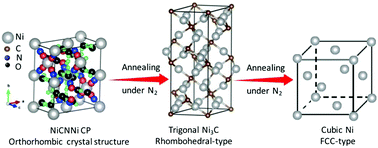Cyanide bridged coordination polymer nanoflakes thermally derived Ni3C and fcc-Ni nanoparticles for electrocatalysts†
Abstract
We report a controlled crystal growth process that enables the design of monocrystalline cyanide bridged coordination polymer (NiCNNi CP) nanoflakes using trisodium citrate dihydrate (TSCD) to control the nucleation rate. TSCD reacted with Ni2+ in the first stage of the reaction to form Ni–TSCD complex. The formed complex enabled few ions of Ni to release steadily and slowly in the reaction solution to interact with [Ni(CN)4]2− ions, thus resulting in the formation of fine NiCNNi CP nanoflakes (an orthorhombic crystal structure). A controlled thermal treatment at 420 °C under nitrogen yielded a trigonal nickel carbide (Ni3C) with similar flake-like morphology. On further heating, a phase transformation occurred and led to the formation of cubic Ni nanoparticles (fcc-type). Both Ni3C and fcc-Ni showed quite good electrocatalytic activity toward the reduction reaction of oxygen (ORR) with strong durability, but fcc-Ni showed better efficacy than Ni3C. The high activity of fcc-Ni nanoparticles could be attributed to the high intrinsic electrochemical activity, corrosion resistance, and chemical stability of Ni metal.



 Please wait while we load your content...
Please wait while we load your content...